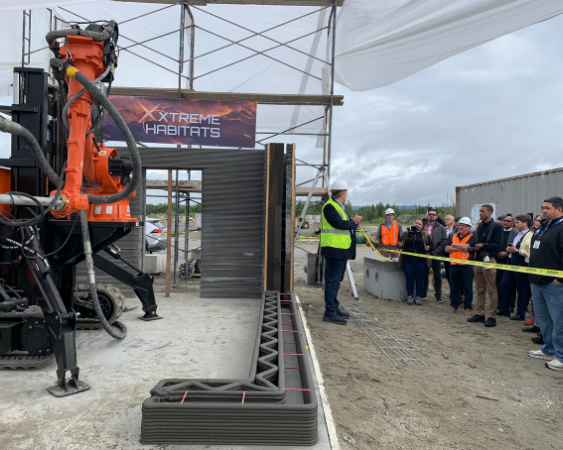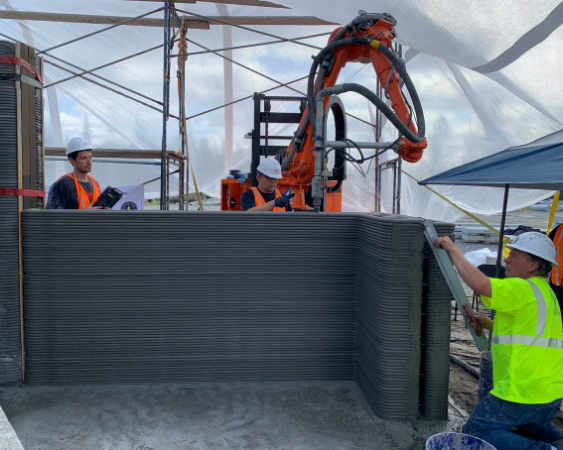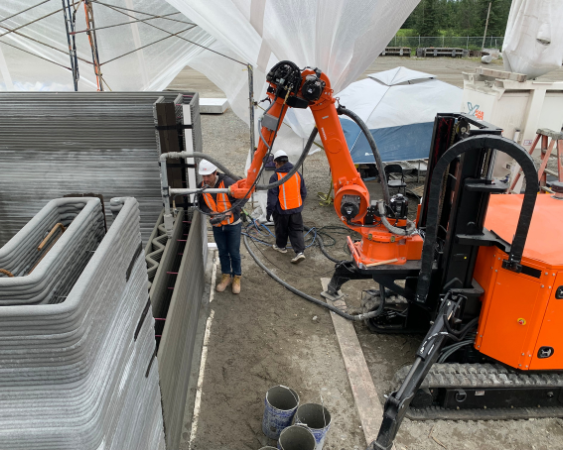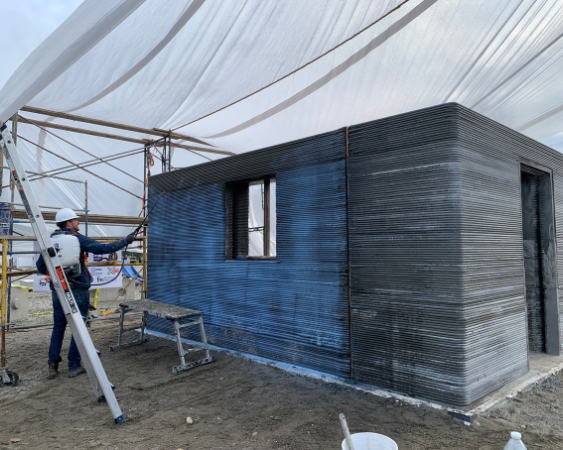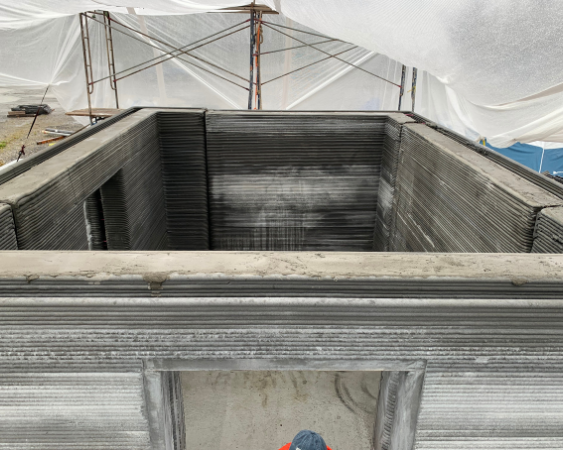Did You Know 3D Printing is Shaping the Future of Housing in Alaska?
August 13, 2024
Building affordable and sustainable homes in Alaska’s remote and often harsh environments is a challenge that lends itself to creative solutions. UA is collaborating with Xtreme Habitats Institute (XHI), X-Hab 3D, Penn State, and other key partners to explore how 3D printing technology can be used to create durable, affordable housing tailored to Alaskans’ unique needs.
A New Era of Housing: In the spring of 2025, a 1,200-square-foot home will be 3D printed in Nome, Alaska, a project that is not just ambitious but potentially essential. This home is designed to withstand Alaska’s extreme weather conditions, drawing on lessons learned from a test structure built in Fairbanks in the summer of 2024 (pictured below) . The Nome house could serve as the blueprint for future sustainable housing in other remote parts of the state.
Zoom In: 3D construction printing technology combines robotics, software, and advanced concrete composite materials to automate the construction process. 3D construction printing could become an alternative to traditional “stick-built” construction, as a means of addressing skilled labor shortages, rising cost of building materials, short building seasons, energy efficiency, durability, and total cost of ownership.
Building on Permafrost: One of the biggest hurdles to construction in Alaska is the permafrost—frozen ground that can make building traditional homes difficult and risky. The team at the University of Alaska Fairbanks (UAF), working with the Cold Climate Housing Research Center and the National Renewable Energy Laboratory, has developed innovative solutions for this. They've designed a special foundation that prevents the heat from the house from thawing the permafrost beneath it, ensuring the home stays secure and the ground stable.
A High-Tech Solution: So, how does this 3D printing process work? The technology, developed by X-Hab 3D, involves a fully mobile system that operates off-grid, perfect for remote locations like Nome. Here’s the basic idea: a mobile 3D concrete printer, equipped with a robotic arm, works in tandem with a concrete mixer and pump to lay down precise layers of concrete. Because this is Alaska, insulation is important. Each structure will be insulated with closed cell expanding foam, a high density and high quality spray foam. This process not only speeds up the construction time but also reduces waste by using just the right amount of material needed.
"The new process also enables complex and unique architectural designs that would be difficult or impossible to achieve with traditional methods and allows for customization. Curved walls, intricate facades, and custom-made components can be printed, offering architects and designers greater creative freedom," says Sven Bilén, Penn State engineering professor and cofounder of X-Hab 3D, who has been working on the project. "Integrating 3D construction printing with other digital construction technologies, such as Building Information Modeling (BIM), can create more efficient and accurate construction processes."
 The robotic arm, donated by Xtreme Habitats Institute, is paired with a concrete mixer
and pump to feed a printhead that lays concrete in different layers. (Photo by Nima
Farzadnia)
The robotic arm, donated by Xtreme Habitats Institute, is paired with a concrete mixer
and pump to feed a printhead that lays concrete in different layers. (Photo by Nima
Farzadnia)
Innovating for Alaska: UAF’s Automated Construction and Advanced Materials (ACAM) Lab is leading the effort to develop locally sourced and produced concrete mixtures using local resources, such as industrial and municipal wastes like fly ash, glass, and paper. These materials can lower construction costs, improve building quality, and speed up the construction process. The project also aims to help develop a material science industry in Alaska. The research will be integrated into UAF’s engineering curriculum, preparing UA students to be leaders in sustainable construction.
Bringing Together Experts: This project is a team effort, bringing together a diverse group of experts. The U.S. Department of Housing and Urban Development (HUD) has provided crucial matching funds, alongside support from the Denali Commission, the Rasmuson Foundation, the City of Nome, and the Alaska Housing Finance Corporation.
- The University of Alaska Anchorage conducted an economic analysis of the potential project in a feasibility study. The results of the six-month feasibility study indicated that this technology had the potential to be successful in Alaska
- Penn State, known for its expertise in 3D printing technology, is handling the architectural and structural engineering, while the Cold Climate Housing Research Center is focusing on the environmental envelope and testing and monitoring the structure over the winter.
- Fairbanks Block and Materials provided the location for printing the test structure, and Local 528 Concrete and Masonry Union provided concrete construction support. In addition, the Innovative Readiness Training Unit of the US Department of Defense is providing logistical support.
Community Collaboration: The project has been closely aligned with the needs and expectations of the Nome community, including Alaska Native groups. The City of Nome, a key sponsor, is ensuring that the project meets local environmental and building codes, while also providing opportunities for workforce development.
At the unveiling of the 3D printer at UAF’s Troth Yeddha campus in Fairbanks on July 30, 2024, representatives from XHI, X-Hab 3D, HUD, Penn State, and other research partners attended. UA President Pat Pitney remarked, “Nome is another 500 miles west, with no road access. Materials are shipped in by barge or delivered by plane. For some goods, there’s only one barge delivery per year. The opportunity to increase the use of local materials for housing and infrastructure in rural Alaska, reduce our dependence on supply chains, and eliminate millions in freight costs - this will be a game-changer.”
 The robotic arm is unveiled at the Usibelli Engineering Learning and Innovation Building
at UAF on July 30, 2024. (UAF photo)
The robotic arm is unveiled at the Usibelli Engineering Learning and Innovation Building
at UAF on July 30, 2024. (UAF photo)
The Future of 3D-Printed Homes in Alaska: This summer, a test structure was printed in Fairbanks to see how the technology holds up in subarctic conditions. The insights gained from this will guide the next phase: building the 1,200-square-foot home in Nome next spring. But this is just the beginning. The long-term goal is to expand this technology to meet the housing needs of other remote and underserved Alaskan communities.
UAF, together with XHI, X-Hab 3D, HUD, and other partners, is at the forefront of bringing innovative, sustainable housing solutions to Alaska. This project is not just about advancing construction technology; it’s about ensuring solutions are tailored to Alaska’s unique environmental, materials, and cultural needs.
Go Deeper:
3D Printing Affordable, Sustainable and Resilient Housing in Alaska
Penn State Tackles Alaska’s Housing Shortage with 3D Printed Homes Initiative
HUD Showcases 3-D Printing as an Innovative Solution for Affordable Housing Supply

